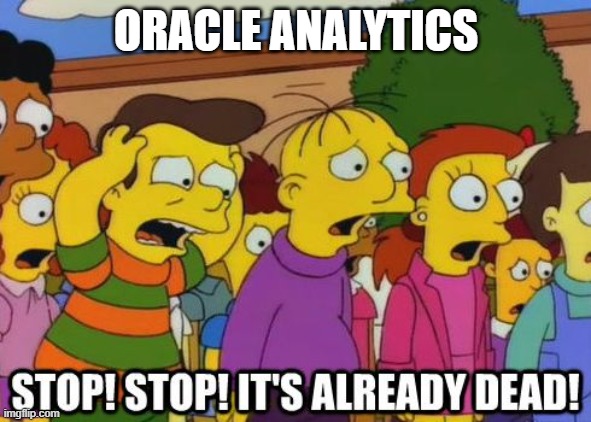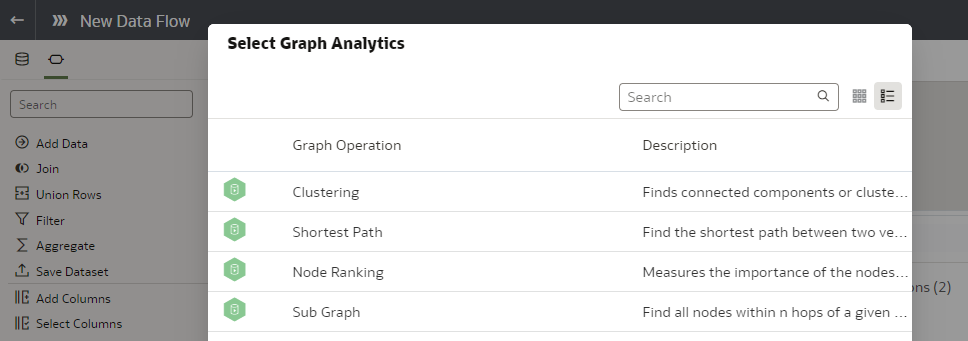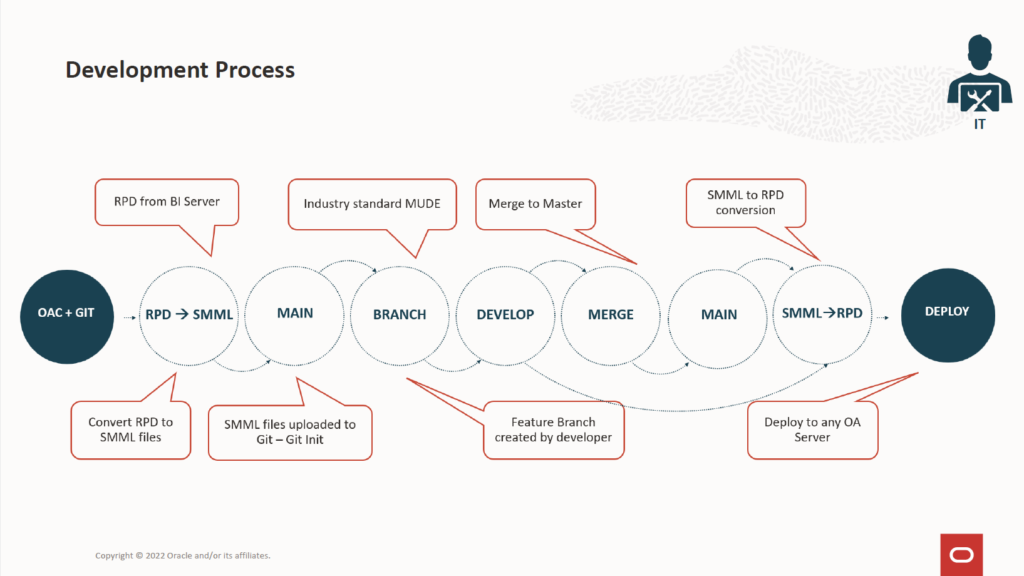“Wait, what? Can you repeat?”, this has been my reaction the first time somebody, a customer using OBIEE for years, told me that Oracle Analytics is dead.
The following time it almost started sounding like a normal comment: several people, both administrators, developers, and managers, told me the same thing over the last 18 months.

It can sound like a surprising message.
Indeed, after OBIEE 12c (Oracle Business Intelligence Enterprise Edition) and Oracle Analytics Cloud (OAC), it felt like the on-premises solution was over, with no news about the future. It was either moving to a competitor or the cloud.
Finally, after almost 2 years, in January 2020 the first Oracle Analytics Server (OAS) was released, and the yearly release schedule was announced.
But … for several users, it felt like OAS wasn’t bringing anything new compared to their OBIEE 12c.
“Classic” (analyses and dashboard) didn’t move, same as before, no new visualization, no new features, but desupported and deprecated features (including things like “act-as”: quite shocking to see it deprecated and disabled by default).
On the other hand, the new features of OAS were all into Data Visualization (DV). But DV was by far not “enterprise-ready” back in 2020, and still isn’t today.
Data Visualization: the Saviour that failed to deliver so far
Over the past three years the changes in OAS have all been focused on DV: bringing most of the DV OAC features (but not all of them) on-premises in OAS.
DV isn’t an OAS new feature, the first iteration was already in OBIEE 12c, 12.2.1.3 I believe, and was called Visual Analyzer.
The “mission” of DV (and VA initially) is to make the analytical platform more accessible to end users, with a special target on business users. Bring the users into the tool, and let them build their analysis and work with data instead of defining some requirements, handing them over to the developer team, and waiting weeks or months to have them delivered. With chances that requirements changed in the meantime or the delivered content isn’t exactly what was needed.
It was the age of “self-service analytics”, and reducing the Time to Insight.
Nothing wrong with that target and considering that a new interface was needed because, no matter how much the “classic” one was tweaked, it wasn’t user-friendly enough for business users.
The issue that the existing customers see is how that new DV interface is the only one evolving over the past years, but it’s still quite far from having all the features that “classic” had. It currently isn’t possible to replace a whole “classic” dashboard with a DV workbook and achieve the same result.
Multiple reasons can explain why DV is disappointing
DV also failed to deliver because of some “debatable” development decisions from day 1. When you start developing in 2015, or not too long later, a whole new interface for an enterprise analytical platform one could imagine it comes with full web services support, fully ready for modern practices, and expanding on top of the excellent existing features.
Automation has been a reality for some time, everything needs to support a scripted way to work with the tool. Everything but DV…
It comes with a very limited number of APIs, only covering a fraction of the new features added to the product. On top of that, there is the OAC vs. OAS gap: when an API is released in OAC it doesn’t mean the same API will be released in OAS with the following yearly release.
The latest Oracle Analytics Roadmap mentions that some new APIs will be released, at some point, in OAC. Fingers crossed that they will be some of the most requested APIs and that they will be released in OAS 2024.
Permissions, privileges, and security in general, were another “interesting” approach. DV is a kind of all-or-nothing: it started with little to no way to set fine-grained permissions on objects. And nowadays it is still missing a proper way to control “who can do what”. OBIEE always had a very fine-grained way of controlling what user can perform what action, on what object with what data. In DV there is a consumer role and an author role, that’s it.
What about application policies? They exist, there is a good number of them behind the generic consumer and author roles. However, there is not a single document explaining what they do, to allow to have custom-tailored application roles.

Here as well there is some kind of hope based on the latest roadmap and an enigmatic “Fine-grain & feature-level permissions” (but having seen how the policies already allow some fine-grained permissions management, I’m optimistic it will go in the right direction).
And then another long list of simple features that were missing in DV and have been added lately, or even that are still missing. Do you need to analyze the data resulting from the union of two sets of data? “Classic” easily supports UNION, DV doesn’t.
Do you need prompts and variables? You are lucky, just released earlier this year: something that has existed in “classic” for more than 15 years just made it into DV.
These are some of the reasons why for many customers, right after upgrading to OAS, the next task was to fully disable DV: lack of fine-grained security, and lack of tooling.
Gartner fanboy? Totally…
The development direction of DV for the first years sounded like somebody was taking the list of the trends that Gartner published and going through it, ticking out the features one by one. One is missing? Let’s add it, somehow, doesn’t matter how well integrated it is, it must be there.
For example, the graph analytics part supported by DV: somebody said “We need graph analytics”, and the answer was “Let’s take whatever we have in stock matching that name, and let’s put it there”. That’s how DV supports, through an Oracle Database, not even a handful of graph algorithms. They are the very few (sub graphs, weakly connected components cluster detection, shortest path, page rank, the triangles counting has not been exposed) supported by the OPG_APIS package that is by default installed with the Oracle Database.

The fact that the property graph product management kind of abandoned that option to move to a fully dedicated Oracle Graph Server supporting 50+ graph algorithms and a full graph query language wasn’t important (or the new SQL ISO standard SQL/PGQ in Oracle Database 23c).
Adding a way to call those few graph algorithms was enough to tick the “graph analytics” checkbox.
Some months ago I was looking for a generic definition of advanced analytics online. I found one in the Gartner Glossary: reading it was like reading the list of DV new features of the past years. Coincidence?
Community? What for? Let’s interface with managers
When a product has existed for 25+ years, you can think that it has a strong community of people using it. It can be forums, online mailing lists (there was a really good one), or being a topic at conferences.
It was the case till OBIEE 12c. Then it started declining…
At one point the solution was even excluded from the Gartner’s Magic Quadrants (can’t remember the full story behind it), and that initiate a number of new initiatives and ways to communicate and market the solution.
Among the new strategies implemented, other than following Gartner in everything they say, there has been a switch to focusing on management instead of the people “running” and using the products.
Part of it has been letting the community die, or kill it directly (faster than having to wait).
That’s what I call taking a forum with more than 60 thousand discussions and migrating it into a brand new, poorly configured, with no real day-by-day management, forum structured as the marketing message is.
Why make categories by product families? No, let’s make categories by the marketing message: OAC, OAS, same business, all focused on self-service and DV.
No surprise nobody was using that new forum, people stopped asking… The next move was to artificially create content, to make the forum look alive, because “a crowd attracts a crowd”, and that’s how any new Oracle employee learning to use DV was pointed to that forum to ask their questions. And there were a handful of other employees knowing DV answering their questions. When you see a forum full of employees asking any kind of questions it doesn’t reassure you about the product itself. On a positive note even on the forum: some end users are back on it asking questions.
As for the conferences, no need to look anymore: Oracle Analytics almost isn’t at conferences anymore. No sessions about it, no attendees for it: all contribute to killing the community.
It all sounds bad, but I like to be optimistic: there is hope!
Many things went not too well over the last few years, and this didn’t support the product much.
The feeling was of a disconnection between the product direction and the reality of customers using it, with common simple and required tasks ignored (like life cycle management in Oracle Analytics).
But it isn’t all that bad.

The product still has features that are very much needed and useful. For example, a central repository lets you map and model your various kinds of sources to generate value for the business: the RPD (now called Semantic Model). By using multiple layers there is a full separation between the physical representation of data and the business view. Allowing to map multiple sources together seamlessly and transparently to the final user.
Self-service is nice, but governed analytics isn’t dead and will still be there for a while: for some things, trusting data is more important than anyone being able to produce (invent?) it in minutes.

This part also received attention with the new Semantic Modeler: a web-based interface to develop the semantic model (RPD) with native git support. It is still an OAC-only feature, but I’m optimistic it will be part of OAS in the 2024 release. The Semantic Modeler allows for a simpler adoption of agile development, with multiple people working on it at the same time and keeping versions natively in git.
My wishes for the future?
I would like for Oracle Analytics to get back in touch with the community of real users: those who install, administer, and support this platform out there in companies.
There are governance needs that are real, management tasks that people still need to perform.
Do you need to work on your catalog offline? For example to recover an object built by an employee who left the company? They don’t tell you how, because the official position is that it isn’t needed, but it is still possible. Don’t make people find an unsupported workaround, just support what has always been possible.
Do you need to automate things in DV? There may not be a full public API, but if you are a bit curious and look at what your browser does, you discover a lot of useful things. And if you need to automate things you can even go as far as using Selenium: the DV interface is fully built by JavaScript, but with some efforts, you can automate tasks with Selenium or use it for some visual regression testing.
Do you need to audit (GDPR etc.) your whole analytical platform, including the DV content, and build a lineage to see where your data is used? Possible, not out of the box and DV does complicate the task, but there are various ways to get what is needed. I had “lot of fun” doing full lineage across the RPD, the catalog, the DV workbooks, datasets, dataflows: it is possible.
My main wish is to not focus only on some Fortune 100 or Fortune 500 managers and hear how happy they are with the product, but to build a real community from the ground up, to collect feedback coming from the people who allow the managers to see (and use) the product.
I could keep going in pointing out reasons why some customers say Oracle Analytics is dead, I could also spend many more words on all the things that could help make the product better and complain about everything…
But I really want to be optimistic, to hope that Oracle Analytics will find its strategy and direction, focusing on maintaining customers and not only acquiring new ones (because acquiring 10 and losing 15 makes for a net loss). Gartner? Sure listen to what they say, but then freely and independently decide what to do: a magic quadrant doesn’t keep a product alive.

Wow finally a REAL blog post where you have the impression, this guy says the truth, no self marketing. Meaning I also believe him, when he says: This is good 😉
Wow, I was in the middle of a mental nightmare in order to envisage how to migrate from OBIEE to OAS, though an initial temptative was somehow disapointing – it didn’t seem to me that I could replicate my whole Analitycs dashboards importing them to OAS, and didn’t know how to build up from scratch new dashboards with all the logic beneath my Analytics dashboards.
After reading your very-interesting-post, it is clear to me that I’ll try to keep alive my OBIEE as long as I can – or as long as Oracle allows me to do it (i.e., new patches / releases availability, official Oracle support alive, etc.).
Thanks for sharing your thoughts with us!
Hi Victor,
It isn’t that bad for your case.
If you have OBIEE 12c, you should migrate to OAS 2023 (or in March/April 2024 the new one: this could be more interesting).
Almost everything you have in your OBIEE still exists in OAS (and will work the same). If you have a custom style it could require some works to get it deployed and adapted. Look at https://docs.oracle.com/en/middleware/bi/analytics-server/whats-different-oas/index.html#GUID-C907A4B0-FAFD-4F54-905C-D6FCA519C262 for the details of what is no longer available, everything else (including desupported or deprecated) is still there!
The key message is that in OAS “classic” (the typical analyses and dashboards) are still fully there, you don’t have to use DV if you don’t want and don’t need it.
If you don’t use DV (you don’t allow any of your users to use it), OAS is just like OBIEE (except for the short list of removed pieces like OSSM etc.).
You should give it a go, mainly now that it’s around for some years. The migration from OBIEE 12c is quite simple all in all (of course if your content comes from previous migrations from 10g or 11g and has never been fully cleaned up and fixing warning etc. it could require some testing to make sure everything is still behaving correctly).
Of course you could ask why? If OAS is mostly the same as OBIEE 12c for your content (not DV), why should you bother in upgrading? It’s mostly to stay on recent versions and be supported. And to be able to more easily benefit from new features in the future (when Semantic Modeler will be available it could let you start exploring and testing it to see if it makes your development process easier for example).